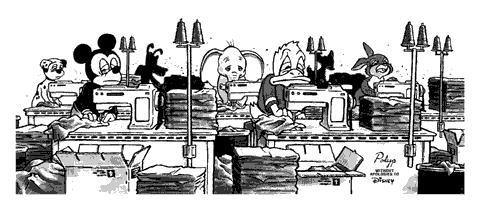Sharon Lin
Blog #3
Fair Trade Coffee; we see the stand outside
of Olson every time we walk to class. We hear about the strikes on coffee and
chocolate companies that utilized inhumane methods to harvest coffee beans and
cocoa beans, but how often do we hear about strikes against other types of
companies. How often do we consciously shop for clothing at certain stores or
intentionally buy from certain retailers that have ‘fair trade’ factories?
In his article Santa’s
Sweatshop in the U.S. News & World Report, authors William J. Holstein,
Brian Palmer, Shahid Ur-Rehman and Timothy M. Ito report on various retailers
that have committed themselves to better treatment of their factory workers as
well as companies that still struggle with issues of ‘fair trade.’ Among the
companies that continue to struggle with ‘fair trade’ many say that problems
stem from incomplete control over the subcontractors that often control the
work in the factories overseas. Audits are done on pay roll and working
conditions in these factories, but the larger company is often fooled by
facades put on by the factory workers and those that run the factories. Things
look good when the companies visit, but in reality, that done, nothing is
getting done.
Companies often believe that the problem is
not easily solved. They claim that unionization would be too costly and that creating
new monitoring jobs would also be an unaffordable extra expense. Furthermore, increasing
minimum wage in many nations would cause many multinational corporations to
move production out of that country. Even according to a prosperous company
such as Disney, “the margin we make on those products is so slim, I’m not sure
we could afford to continue to manufacture there” (Holstein 4). This happened to
a factory southern China in 2007, which shut down due to employees demanding a
raise in wages (Fowler B13).
To me, however, these reasons all sound like
excuses. The main reason the aforementioned problems remain unsolved is a lack
of funds. I find this hard to believe. In the same Disney factory that commented
that a raise in minimum wage would cause Disney to move its manufacturing, “workers…received
6 cents for producing this item, which retails for $19.99 in the United States”
(Holstein 4). That’s an over 300% increase in price from the price they paid
for the labor. While we must take into consideration the price of shipping, and
base products, the its seems improbable that the margin of profit could be “so
slim” that they could not afford to better the pay to their factory workers.
Furthermore, the company itself is very profitable. “Disney posted $1.1 billion in net income
for fiscal 1994, compared with $890 million a year earlier” (Ceniceros 3). I am dubious that Disney, among
other companies that act in similar fashion, truly cannot afford to raise
workers’ wages. I simply think that because Disney can choose to manufacture at
lower prices because the competition for production jobs in third world
countries is competitive. If someone chooses not to do the work for a certain
wage, another person will eager step into his or her place.
I end with a question that will now
forever plague me every time I think of purchases Disneyland Hopper tickets. “High prices, low wages. Why Disney?” (Ceniceros
3).
Be
Green Challenge; Week 3:
This week was easier since I was
busy all week and had few moments of downtime to think about shopping. On
Saturday, however, I went with a few friends to have dinner in a restaurant at
Arden Fair Mall. The wait time was an hour so my friends decided to go into the
mall. I felt much less tempted to purchase items than I would have in the past!
I think this challenge is definitely changing something! As we were shopping,
however, my friend saw a dress she particularly liked. When she uttered the
price of $198 dollars and mentioned how it was “not bad” I began to realize how
brainwashed we were in this consumer culture. It shocked me that she would even
consider paying that much for a dress as a college student. Perhaps I am stingy
and cheap, however, I believe that a dress is a dress. One can buy a $20 dress
and wear it for just as many occasions.
After watching the film about the
Latino workers law suit/settlement against Forever 21, however, I wonder if the
higher priced item would have more humane factory conditions and better factory
labor wages.
Inside Source: Holstein, Palmer,
Ur-Rehman, Shahid, Ito. “Santa’s Sweatshop: In a Global Economy, It’s Hard to
Know Who Made Your Gift—and Under What Conditions.” Reader.
Outside Sources:
Ceniceros, Roberto. "Managed Care Discord
Stalls Labor Talks At Disney World."Business Insurance 28.50
(1994): 3. Print.
Fowler, Geoffrey A. "Protests Aimed at
Disney Show China Labor Unrest." Wall Street Journal - Eastern
Edition 249.31 (2007): B13. Print.



No comments:
Post a Comment